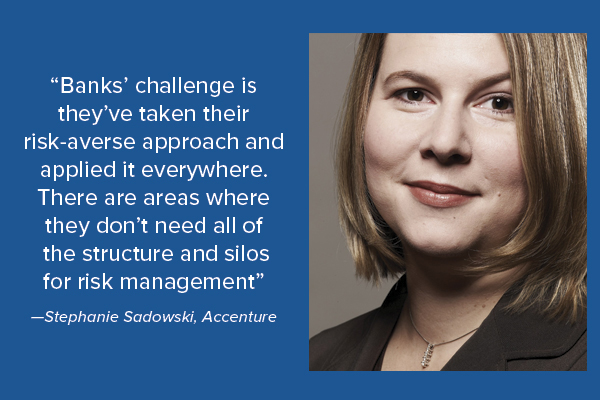Agile Banking: How you remain relevant
Tech merges with strategy for quick, decisive, cross-organizational action
- |
- Written by John Ginovsky
 How is your bank becoming agile? Share your thoughts and strategies in the comment section at the conclusion of this roundup of bankers and experts.
How is your bank becoming agile? Share your thoughts and strategies in the comment section at the conclusion of this roundup of bankers and experts.
"Agile banking,” a term of the moment, becomes something to take seriously when it is shown to cut costs, increase efficiency, please and retain customers, empower employees, and add to the bottom line.
Make no mistake, agile banking is a real thing.
Some banks, big and small, have started to recognize its merits. A few of those have actually implemented it in some way and have shown results. Some say it’s the future of retaining relevancy for banking as a whole, even as both technology and business operations in the wider world evolve.
Take an example at a real bank. A chief appraiser comes into a bank and finds that the whole appraisal system runs on 1990s-era Microsoft applications. Basic customer information is rekeyed into different bank systems up to six times with associated forms printed out, distributed to different office in-boxes and checked, then redistributed for signature, consolidated, and processed some more until final approval.
“I’ve been with the bank four years,” says Michael Pratico, chief appraisal officer at Columbia Bank, Fair Lawn, N.J., in an interview with Banking Exchange. “I was never in banking before. When I came and saw how we were doing this, I literally watched people typing in the addresses of properties four, five, six times.”
I thought, ‘This is just stupid.’”
As a result, this area of the bank formed a unit based on agile banking principles of quick, iterative, collaborative decision-making, ending with the adoption of a new workflow tool. This allowed for changing most of the process from manual to digital, according to Pratico, where information is keyed in once and shared, and most actual paperwork is eliminated.
“For the same amount of payroll [in our department], over a three-year period,” Pratico says, “we’re producing 25% more work. Also, when I talk to the two administration folks, they are so much happier not to be doing the redundancy and the printing and so forth. Instead, now they’re helping frame out appraisal reviews and doing basic analysis.” The $5.1 billion-assets bank also will save thousands of dollars every year on document imaging, he adds.
What is Agile Banking?
Agile banking seems to work. But what is it? On one level, various bankers and consultants gave various definitions in interviews with Banking Exchange. As a whole, they paint a pretty clear picture.
“I would define agile as being prepared and being able to take advantage of opportunities in the market. It also is being open-minded and willing and courageous enough to do it,” says Steve Miller, president and CEO of $334 million-assets Fresno First Bank, Fresno, Calif.
Stephanie Sadowski, managing director, FS Distribution & Marketing Practice, North America lead, Accenture Consulting, puts it this way: “It would be operating a more collaborative and quickly adaptable financial organization that is driven more by knowledge and information.”
According to Steve Williams, founder of Cornerstone Advisors and lead of its strategic planning practice: “It is the idea of being more quickly adaptable to competitive and market conditions.”
“To me, agile banking is taking the concepts of ‘faster’ and ‘easier’ and inculcating them in all parts of the operation,” says Joseph Cady, managing partner of CS Consulting Group.
A technologist’s view adds further dimensions. “People sometimes misinterpret agility as reorganizing so they can get stuff done quicker,” says Alexei Miller, managing director of DataArt, a technology consultancy and builder of proprietary systems. He points out that agility is three concepts mixed together: pace of development, being able to change along the way, and regular production of something useful. “Technology people put particular emphasis on the last one,” he says.
The danger, though, is assuming that agility just has to do with technology. While the concept of agility has its roots in software development, it goes much deeper as it applies to banking. Agility relates more to the intersection of new technology with a broader, less-siloed approach to business strategy, organization, and process.
“The idea is you need to start taking the management and operations of a financial organization and start adapting some of the things that have made technology companies viable,” says Williams. “Agile started in the software business, but as an idea of bringing knowledge, collaboration, and adaptability. Some of those principles work in terms of running an organization.”
“You can start to think about the concept of ‘DevOps’ versus having a development team and an operations team,” points out Sadowski. “If you are constantly improving things, those two become one to get better collaboration. It’s a huge cultural and organizational change.”
From a practical point of view, Fresno First’s Miller says: “It just allows us to have a better process for a lot cheaper.”
This is a sentiment that bigger banks share. In an essay published on the Financial Services Roundtable website, Greg Carmichael, president and CEO of Fifth Third Bank, the $143 billion-assets, Cincinnati-based regional, explains why.
“To me, technology needs to help solve a business problem or create a business opportunity,” Carmichael writes. “Technology is a means to an end, allowing us to do something faster, better, and cheaper. Most important, it allows us to better serve our customers.”
Why do it? —internal pressures
Fundamentally, agile banking focuses on improving conditions for customers of all types, starting with internal customers, such as the ones Pratico’s appraisal group at Columbia Bank has.
“In our case, our customers are really the lending and risk management [departments],” Pratico says. “We have internal customers. We were finding that the process we were using to manage was so disjointed that people were often in the dark. No one knew what was happening until the very end.”
Miller says much the same thing about Fresno First Bank. “It [agile banking] is the intention of trying to improve internal processes that affect internal and external customers—not just processes that affect external customers, but the whole idea of having a faster service time and response time to [all] our customers.”
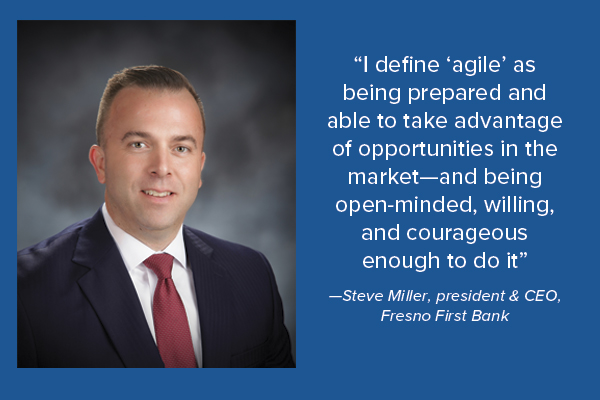
This, again, has practical implications. “If I went into a bank today and said they are going to have to do three times as many loans tomorrow as they do today, they would have no choice but to add about twice as many people to get that done,” maintains Michael Croal, consultant, Agile Banking. “When you have more digital processes, you can scale. You don’t have to add people.”
Why do it? —external pressures
It pretty much comes down to keeping up with the competition, which increasingly includes not only other banks, but also nonbank innovators.
“I was in the banking business for 20 years,” says J. P. Nicols, who is now a banking consultant and managing director of the FinTech Forge. “For most of my career, we just thought about what other banks were doing. Our competitors were very well defined and a very small number of them. Now, it is possible to live your financial life without a primary relationship with a bank. Every single line of business that every bank is in now has one or more nonbank competitors, let alone the way big banks have really fueled the fintech arms race.”
Research also points to the ever-changing, ever-demanding expectations of consumers. In a recent report, Alan McIntyre, senior managing director, head of Accenture Banking, says: “Consumers expect nearly all of their transactions to be on par with the service they receive from ‘GAFA’ [Google, Amazon, Facebook, and Apple] companies, which poses a challenge for banks in particular. Banks need to create branches that provide an advanced digital experience combined with convenient locations, while also developing an online digital experience that can compete head on with the tech giants.”
It’s not only the tech giants, but others in banking.
“The large institutions are taking lessons from the fintechs and applying them to their systems. Community banks that don’t recognize this, at some point, they risk becoming irrelevant,” says CS Consulting Group’s Cady.
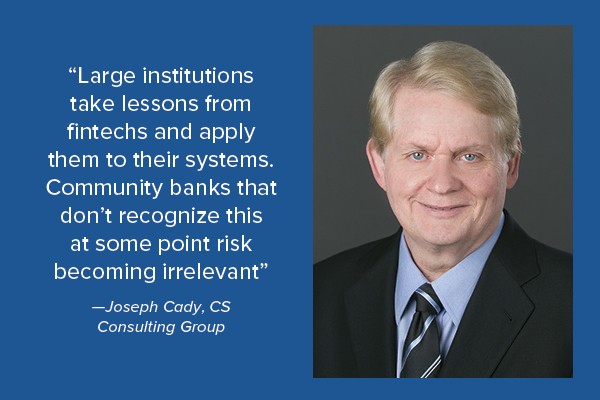
Fifth Third’s Carmichael makes this clear in his essay, writing: “The majority of financial services innovation will likely continue to happen outside of banks, as it has in the past few years. However, I believe that the majority of value creation will happen within banks, as banks will continue to serve customers. This complementary relationship creates a win-win-win for the banks, for fintechs, and more importantly, for our customers. At Fifth Third, we have a holistic ‘build-partner-buy’ strategy on financial technology.”
Miller’s bank, Fresno First, recognizes this situation. With the agile banking approach, he points out, “We can pretty much do 95% of the stuff the big banks do, and there’s really not much of a cost hindrance.”
Iteration is key
One word comes up time and again when talking about agile banking: “Iteration.”
“The idea of iteration is that things change too quickly,” says Cornerstone Advisors’ Williams. “Organizations slow themselves down too easily. Instead of shooting from A to Z, you have to first build A and then build B and go on that way as you learn. There also is that continuous feedback loop that makes you build something more accurate because you’re learning and updating each time.”
Put another, more conceptual way, consultant Nicols says: “[Iteration] is a course correction, but it’s also a faster course correction. If you sail a ship and you are one degree off course, solving that in the first half hour isn’t a big deal; solving it 12 hours into your cruise, now you’re hundreds of miles off of where you are supposed to be. So the important part is making little course corrections regularly, not at the end of the project.”
Nicols adds: “There is an element in agile called a ‘sprint’ when you have a short one- or two-week process to get something done or create a specific feature. The real purpose of a sprint not only is to move quickly, but to move incrementally and iteratively. Each iteration should be better than the last.”
In other words, make quick and constant tweaks not only to stay on track, but to improve the track even as circumstances and the environment change. “The minute you find something sliding, you have to go after it and be very aggressive about it,” Fresno First’s Miller says. “So it’s a constant process. Process improvement is not a ‘one-off.’ It’s an evolving thing, a living, breathing part of business. Once you start, you have to stay committed.”
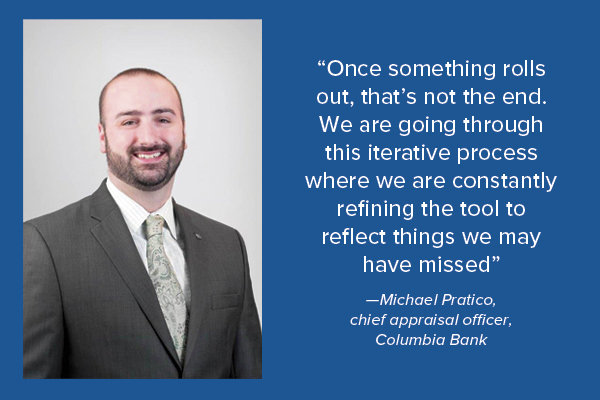
In a like vein, Columbia Bank’s Pratico points out: “Once something rolls out, that’s not the end. We are going through this iterative process where we are constantly refining the tool to reflect things that we may have missed or not thought about. The environment is changing pretty rapidly. What we thought made sense 12 months ago may not be quite as applicable now, just because of the evolution of the market.”
Inertia vs. leadership
People interviewed for this article suggest that adopting an agile banking approach requires a fundamental change in culture and comfort zones. There will be resistance. To be successful, organizations need leadership from the top and enthusiasm through the ranks.
“There were internal roadblocks” when Fresno First Bank started changing things, Miller admits. “There was just lack of knowledge or fear of making progress. The same people who complain about the process, when you give them a very good solution to fix it, they complain about the solution. I’d say that’s human nature. As senior managers, you have to stay committed to seeing it through and recognizing who the real roadblocks are. If they are truly, truly trying to derail something, then you go right after it. You have to either convince them or move them out of the way.”
In Columbia Bank’s case, Pratico found support from his staff. “I started talking about it with my staff, and I was blessed, and maybe unusually so. Just about all of them were hungry for this change. When I presented the idea, there was a lot of interest. The other key, too, and this is probably true for any kind of change: They were involved at every step of the process. They had a vote. We literally sat down every bit of a dozen times, formally, and came up with ratings and metrics and how we would look at them. When we finally made the choice, it wasn’t my choice. It wasn’t the CEO’s choice. It wasn’t one appraiser’s choice. It was the department’s choice. When you own the decision, you’re more likely to embrace it.”
A lot of it ties back to leadership culture and organizational structure, Accenture’s Sadowski notes. “When you look at how traditional banks are structured, they are very siloed, very regulated, and very bureaucratic,” she says. “The reason they go there is sound logic. They are all managing risk. The challenge is they’ve taken that risk-averse approach and applied it everywhere. There are areas where they don’t need all of the structure and silos for risk management, and they need to pivot in order to empower their people to deliver stuff sooner.”
Agile Banking’s Croal champions the idea of designating a specific “process owner,” who has the clout and the acumen to align the path that given transactions take across the organization, such as between lending departments, compliance departments, servicing departments, and so on.
“The process owner needs to have an understanding of the impact of operational efficiency to the profitability [of the organization],” Croal says. “It has to be somebody who knows banking.”
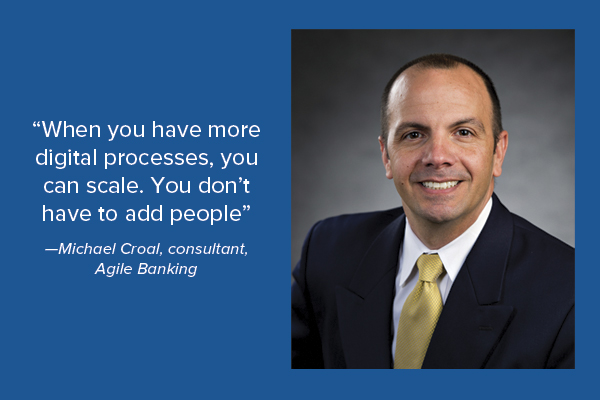
The process owner doesn’t do the fixing, Croal adds. That person needs a team to reengineer the process, and the team should include stakeholders from all the affected areas. Further, he says, the process owner “needs to have a say that if this particular technology can’t integrate [with other systems], then get rid of it and get something else. Or if these employees can’t perform their jobs correctly after they have been educated, he or she can say, ‘I don’t want them any more.’”
Measuring success
Numbers don’t lie, as Fresno First’s Miller points out. “When you make a change, you have to track it. You show people what you’re doing, make sure you train people the right way and educate them, and communicate clearly. Then you track the hell out of it so people know that it’s working. Then, for any of the naysayers, you can shut them up pretty quick.”
Croal estimates that banks can shave 10 to 15 percentage points from their efficiency ratios with digitally agile processes. “This is worth $750,000 to $1 million per year for the median community bank between $100 million and $2 billion in assets,” he says.
But it’s not all profit and loss numbers. “Managing innovation is different than managing business as usual,” says consultant Nicols. “You have to look at metrics that aren’t financial early on. You have to look at how many new products did you launch? What percentage of our ideas are coming from new sources? How much faster are we moving on those things?”
The wrap-up
Agile banking is just taking hold. It could be the thing that keeps banking relevant.
“I left my 20 years of banking in 2012,” says Nicols. “What I’ve been focusing on since then is this intersection of banking and fintech innovation. In 2012 and 2013, I got a lot of bemused smiles, paternalistic pats on the back, a lot of ‘That’s cute, son. I run a real business.’ In 2015 and 2016, many of those same directors and CEOs were calling me. The tide is beginning to change, but it’s still a long battle.”
Consultant Cady puts it this way: “Banking is at the cusp of a huge seismic change. It’s coming, and how you remain relevant, that’s the overriding question. The answer is agile banking.”
Read the companion article, "Collaboration, not competition"
This article originally appeared as the cover story in the February-March Banking Exchange.
Tagged under Management, Duties, HowTo, Community Banking, Feature, Feature3,












